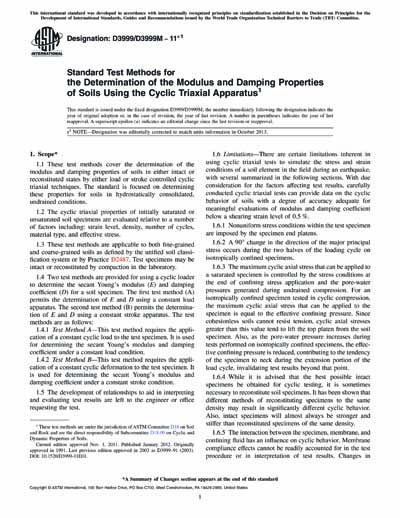Historical
ASTM D3999/D3999M-11e1
Standard Test Methods for the Determination of the Modulus and Damping Properties of Soils Using the Cyclic Triaxial Apparatus
1.1 These test methods cover the determination of the modulus and damping properties of soils in either intact or reconstituted states by either load or stroke controlled cyclic triaxial techniques. The standard is focused on determining these properties for soils in hydrostatically consolidated, undrained conditions.
1.2 The cyclic triaxial properties of initially saturated or unsaturated soil specimens are evaluated relative to a number of factors including: strain level, density, number of cycles, material type, and effective stress.
1.3 These test methods are applicable to both fine-grained and coarse-grained soils as defined by the unified soil classification system or by Practice D2487. Test specimens may be intact or reconstituted by compaction in the laboratory.
1.4 Two test methods are provided for using a cyclic loader to determine the secant Young's modulus (E) and damping coefficient (D) for a soil specimen. The first test method (A) permits the determination of E and D using a constant load apparatus. The second test method (B) permits the determination of E and D using a constant stroke apparatus. The test methods are as follows:
1.4.1 Test Method A—This test method requires the application of a constant cyclic load to the test specimen. It is used for determining the secant Young's modulus and damping coefficient under a constant load condition.
1.4.2 Test Method B—This test method requires the application of a constant cyclic deformation to the test specimen. It is used for determining the secant Young's modulus and damping coefficient under a constant stroke condition.
1.5 The development of relationships to aid in interpreting and evaluating test results are left to the engineer or office requesting the test.
1.6 Limitations—There are certain limitations inherent in using cyclic triaxial tests to simulate the stress and strain conditions of a soil element in the field during an earthquake, with several summarized in the following sections. With due consideration for the factors affecting test results, carefully conducted cyclic triaxial tests can provide data on the cyclic behavior of soils with a degree of accuracy adequate for meaningful evaluations of modulus and damping coefficient below a shearing strain level of 0.5 %.
ASTM International [astm]

